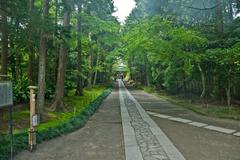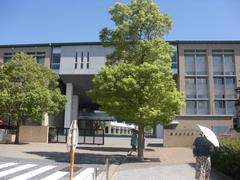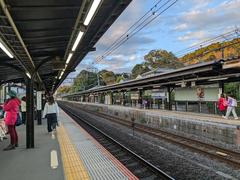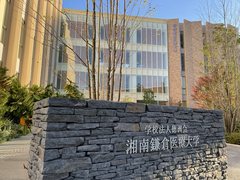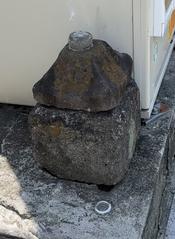
Kamakura Station Visiting Hours, Tickets, and Guide to Kamakura Historical Sites
Date: 14/06/2025
Introduction: Kamakura Station—Gateway to Samurai Heritage
Located in Kanagawa Prefecture, Kamakura Station is the main entry point for travelers eager to explore a city steeped in samurai history, Zen culture, and stunning coastal scenery. Since its opening in 1889, the station has connected visitors from major cities like Tokyo and Yokohama via the JR Yokosuka and Shonan-Shinjuku Lines, while the Enoshima Electric Railway (Enoden) offers charming, scenic rides to seaside and cultural highlights (Trip to Japan; Japan Guide).
This comprehensive guide covers everything you need to know for a seamless Kamakura visit, including:
- Kamakura Station visiting hours and ticket options
- How to access Kamakura and navigate local transportation
- Opening hours and pricing for major historical sites
- Accessibility, practical tips, and etiquette
- Accommodation and dining near Kamakura Station
- Seasonal events and cultural highlights
Whether you’re on a day trip or planning an extended stay, understanding these essentials will help you make the most of your time in Kamakura.
Table of Contents
- Kamakura Station: Visiting Hours, Ticket Options, and Station Information
- Accessing Kamakura: Rail, Enoden, and Local Connections
- Major Historical Sites: Opening Hours, Tickets, and Highlights
- Getting Around Kamakura: Transportation, Passes, and Walking Routes
- Accommodation and Dining Near Kamakura Station
- Visitor Information: Accessibility, Safety, and Etiquette
- Seasonal Events, Festivals, and Cultural Experiences
- Frequently Asked Questions (FAQ)
- Key References and Official Resources
Kamakura Station Visiting Hours, Ticket Options, and Station Information
Station Hours and Services
- Operating Hours: Kamakura Station is open daily, with train services running from approximately 5:00 AM to midnight. The ticket office is generally staffed from 5:30 AM to 11:00 PM. Automated ticket machines are available 24/7 (Japan Guide).
- Lines Served: JR Yokosuka Line, JR Shonan-Shinjuku Line (direct to Tokyo and Yokohama), and Enoshima Electric Railway (Enoden) for coastal destinations.
- Tourist Information: Multilingual assistance, city maps, and brochures available at the east exit’s tourist center.
Ticket Options
- IC Cards: Suica and Pasmo are accepted on all trains, buses, and the Enoden line for seamless travel.
- Enoden One-Day Pass (Noriorikun): Unlimited rides on Enoden for a day—convenient for temple hopping and beach visits.
- Kamakura Free Kankyo Tegata: Day pass for unlimited city bus rides—ideal for covering wider areas (Time Travel Turtle).
- Japan Rail Pass Holders: JR lines to Kamakura are included, but Enoden rides require separate tickets.
Accessing Kamakura: Rail, Enoden, and Local Connections
Rail Access from Tokyo, Yokohama, and Beyond
- JR Yokosuka Line: Direct from Tokyo Station (about 1 hour, 950 yen); also serves Shinagawa and Yokohama (Japan Guide).
- JR Shonan-Shinjuku Line: Direct from Shinjuku (about 1 hour, 950 yen); some trains require a transfer at Ofuna.
- From Yokohama: Both JR lines reach Kamakura in about 25 minutes (340 yen) (Time Travel Turtle).
Local Rail Connections
- Enoden (Enoshima Electric Railway): Connects Kamakura with Hase, Yuigahama, Enoshima, and Fujisawa. Famous for nostalgic rides and ocean views (Matcha).
- Kita-Kamakura Station: One JR stop north, convenient for Zen temple visits.
Ticketing
- IC Cards are recommended for convenience across all modes of transport.
- Day Passes (Enoden or bus) can be purchased at station counters or machines.
Major Historical Sites: Opening Hours, Tickets, and Highlights
Tsurugaoka Hachimangu Shrine
- Location: 10-minute walk from Kamakura Station via Komachi-dori.
- Hours: 6:00 AM–8:00 PM; free entry.
- Highlight: Cherry blossoms in spring, Yabusame (horseback archery) in April/September (Kamakura Welcome Guide; Tsurugaoka Hachimangu).
Kotoku-in (Great Buddha of Kamakura)
- Location: Near Hase Station (Enoden line), 10-minute walk from station.
- Hours: 8:00 AM–5:30 PM (April–Sept), 8:00 AM–5:00 PM (Oct–March).
- Tickets: 300 yen; extra fee to enter inside the statue.
- Highlight: Iconic 11.4-meter bronze Buddha (Japan Guide; Kōtoku-in).
Hasedera Temple
- Location: 5-minute walk from Hase Station (Enoden).
- Hours: 8:00 AM–5:00 PM; last admission 4:30 PM.
- Tickets: 400 yen.
- Highlight: Hydrangea gardens in June, panoramic bay views (Hasedera).
Other Notable Sites
- Meigetsuin (Hydrangea Temple): 9:00 AM–4:30 PM; 300 yen. Famous for hydrangea blooms in June (Meigetsuin).
- Hokokuji (Bamboo Temple): 9:00 AM–4:30 PM; 300 yen. Known for its bamboo grove.
- Zeniarai Benten Shrine: 8:00 AM–4:30 PM; free. Unique ritual of washing money for good luck.
- Engaku-ji & Kencho-ji Temples: 8:30 AM–4:30 PM; 300 yen each. Important Zen temples near Kita-Kamakura.
Getting Around Kamakura: Transportation, Passes, and Walking Routes
Walking
- Most central sites (Tsurugaoka Hachimangu, Komachi-dori, Yuigahama Beach) are within 10–15 minutes’ walk from Kamakura Station.
- Suggested Walking Route: Kamakura Station → Komachi-dori → Tsurugaoka Hachimangu → Kencho-ji → Engaku-ji → Kita-Kamakura Station.
Enoden (Tram)
- Connects Kamakura with Hase (Great Buddha, Hasedera), Enoshima, and Fujisawa.
- Tips: Buy the Noriorikun one-day pass for unlimited rides (Japan Guide).
Buses
- Convenient for reaching temples not on train lines, such as Hokokuji and Zuisen-ji.
- Pass: Kamakura Free Kankyo Tegata covers unlimited rides for a day.
Taxis and Bicycle Rentals
- Taxis available at both exits; metered fares.
- Bicycle rentals near the station offer flexibility but beware of narrow streets (Talk to Japan).
Accommodation and Dining Near Kamakura Station
Where to Stay
- Hotels & Ryokan: Options range from modern hotels like Hotel Metropolitan Kamakura and Tosei Hotel Cocone Kamakura to artistic hostels (Villa Sacra) and traditional ryokan (Booking.com; Live Japan).
- Guesthouses: Affordable and sociable, with women-only options like Ano House.
- Best Areas: Near the station for convenience, or Hase/Yuigahama for seaside views.
- Nearby Towns: Ofuna (6 minutes by train) offers extra choices if Kamakura is booked.
Dining Highlights
- Komachi-dori: Lined with local snack stalls (sweet potato chips, matcha ice cream, shirasu croquettes) and souvenir shops.
- Notable Restaurants:
- Takeru Quindici: Italian-Japanese fusion (Savor Japan).
- Kitakamakura En: Refined Japanese fare.
- OXYMORON: Curries with ocean views (Matcha Japan).
- Jazz Cafe MILK HALL: Classic cafe with Taisho-era ambiance (Matcha Japan).
- Tsubame Cafe: Traditional meals with local shirasu (Stephano.me).
- Toyoshimaya: Sweets and Japanese breads (Matcha Japan).
- Vegetarian/Vegan: Many cafes cater to dietary needs; check menus or ask staff.
Visitor Information: Accessibility, Safety, and Etiquette
- Accessibility: Kamakura Station has elevators, ramps, and accessible toilets. Major sites vary in accessibility due to historic architecture—check ahead (Japan Guide).
- Coin Lockers: Available at the station for luggage storage.
- Wi-Fi: Free at Kamakura Station and many cafes/hotels (Japan to Visit).
- Safety: Kamakura is very safe for tourists (Hikersbay).
- Etiquette: At temples and shrines, bow at torii gates, cleanse hands at water basins, and keep noise down. Tipping is not customary.
Seasonal Events, Festivals, and Cultural Experiences
- Cherry Blossom Season: Late March to early April, especially at Tsurugaoka Hachimangu.
- Hydrangea Season: June at Hasedera and Meigetsuin (may require special tickets due to crowds; Hasedera Official).
- Kamakura Festival: April, featuring parades and Yabusame.
- Fireworks Festival: July at Yuigahama Beach.
- Zen Experiences: Meditation sessions and temple stays at Kencho-ji and Engaku-ji (Adventure Backpack).
- Local Crafts: Kamakura-bori lacquerware galleries near the station.
Frequently Asked Questions (FAQ)
Q: What are Kamakura Station’s operating hours?
A: Approximately 5:00 AM to midnight daily; ticket office 5:30 AM–11:00 PM.
Q: Can I use my Japan Rail Pass to reach Kamakura?
A: Yes, on JR lines to Kamakura, but not on the Enoden line.
Q: Are there special passes for tourists?
A: Yes, Enoden One-Day Pass and Kamakura Free Kankyo Tegata are recommended.
Q: Which sites are accessible for those with limited mobility?
A: Kamakura Station and some temples are accessible; others may have steps or uneven paths—check details in advance.
Q: Are guided tours available?
A: Yes, bookable online or at the tourist information center.
Q: Do I need to cover tattoos at beaches or baths?
A: Some establishments request tattoos be covered—look for signs or ask staff (Live Japan).
Key References and Official Resources
- Trip to Japan: Kamakura City Travel Guide
- Japan Guide: Kamakura Access and Travel
- Japan Guide: Kamakura Great Buddha
- Kamakura Welcome Guide
- Live Japan: Kamakura Travel Information
- MATCHA: Kamakura Travel Tips
- Time Travel Turtle: Kamakura Day Trip
- Booking.com: Kamakura Station Hotels
- Savor Japan: Kamakura Restaurants
- Hasedera Official
- Meigetsuin
- Kōtoku-in (Great Buddha)
- Tsurugaoka Hachimangu
- Talk to Japan: Kamakura Transportation
- Stephano.me: Kamakura Cafes
- Japan to Visit: Kamakura Travel Guide
- Adventure Backpack: Kamakura Culture
- Hikersbay: Kamakura Tourist Information
Final Tips and Call to Action
Kamakura Station is your starting point for a journey through Japan’s living history, tranquil temple gardens, and vibrant coastal life. Plan ahead for seasonal highlights, secure tickets and passes for hassle-free exploration, and immerse yourself in the city’s authentic charm.
For the latest updates, maps, and insider tips, download the Audiala app, visit official tourism websites, and follow trusted travel resources. Enjoy your Kamakura adventure!

